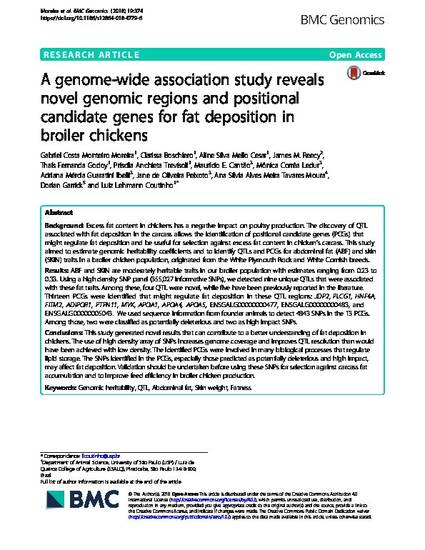
Background: Excess fat content in chickens has a negative impact on poultry production. The discovery of QTL associated with fat deposition in the carcass allows the identification of positional candidate genes (PCGs) that might regulate fat deposition and be useful for selection against excess fat content in chicken’s carcass. This study aimed to estimate genomic heritability coefficients and to identify QTLs and PCGs for abdominal fat (ABF) and skin (SKIN) traits in a broiler chicken population, originated from the White Plymouth Rock and White Cornish breeds.
Results: ABF and SKIN are moderately heritable traits in our broiler population with estimates ranging from 0.23 to 0.33. Using a high density SNP panel (355,027 informative SNPs), we detected nine unique QTLs that were associated with these fat traits. Among these, four QTL were novel, while five have been previously reported in the literature. Thirteen PCGs were identified that might regulate fat deposition in these QTL regions: JDP2, PLCG1, HNF4A, FITM2, ADIPOR1, PTPN11, MVK, APOA1, APOA4, APOA5, ENSGALG00000000477, ENSGALG00000000483, and ENSGALG00000005043. We used sequence information from founder animals to detect 4843 SNPs in the 13 PCGs. Among those, two were classified as potentially deleterious and two as high impact SNPs.
Conclusions: This study generated novel results that can contribute to a better understanding of fat deposition in chickens. The use of high density array of SNPs increases genome coverage and improves QTL resolution than would have been achieved with low density. The identified PCGs were involved in many biological processes that regulate lipid storage. The SNPs identified in the PCGs, especially those predicted as potentially deleterious and high impact, may affect fat deposition. Validation should be undertaken before using these SNPs for selection against carcass fat accumulation and to improve feed efficiency in broiler chicken production.
Available at: http://works.bepress.com/james_reecy/125/

This article is published as Moreira, Gabriel Costa Monteiro, Clarissa Boschiero, Aline Silva Mello Cesar, James M. Reecy, Thaís Fernanda Godoy, Priscila Anchieta Trevisoli, Maurício E. Cantão et al. "A genome-wide association study reveals novel genomic regions and positional candidate genes for fat deposition in broiler chickens." BMC genomics 19 (2018): 374. doi: 10.1186/s12864-018-4779-6.